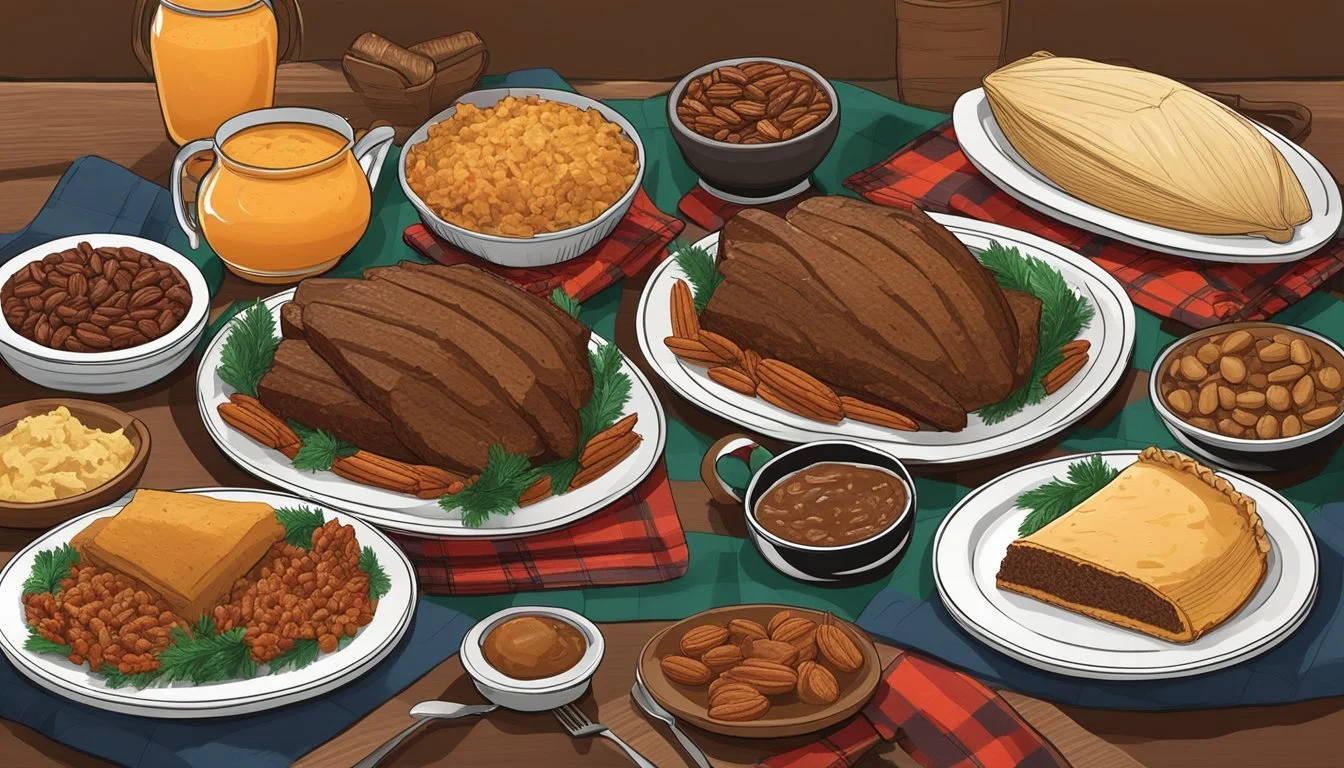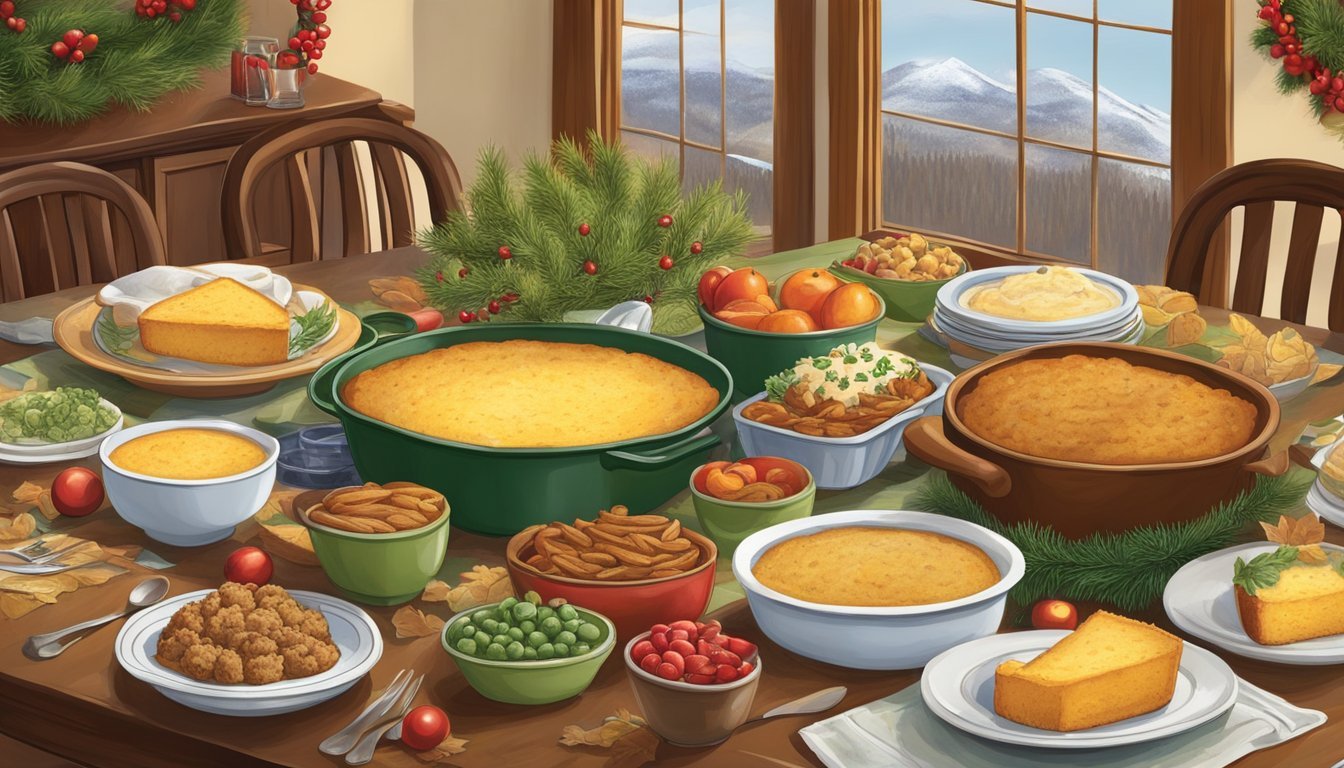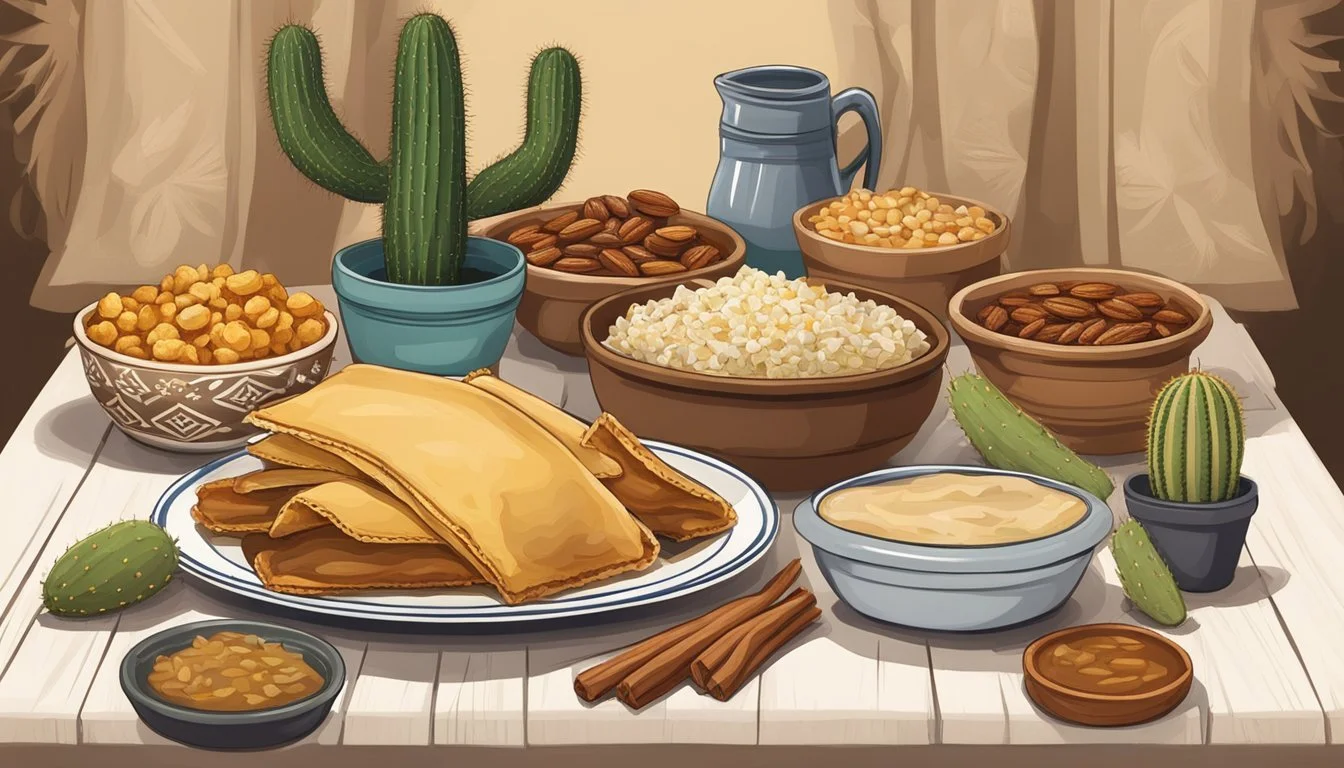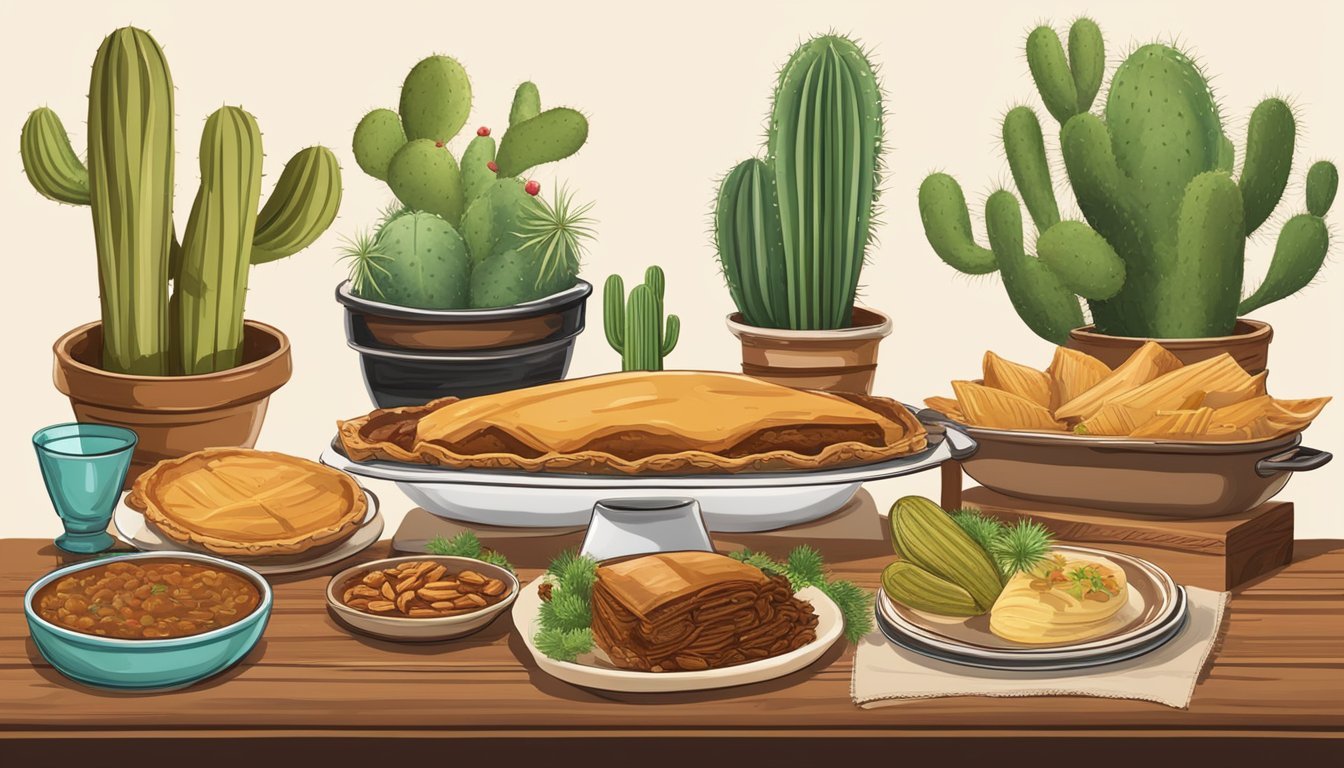7 Texas Food Traditions for Christmas
A Festive Culinary Journey
The holiday season in Texas is a unique blend of diverse culinary traditions that reflect the state's rich cultural tapestry. From savory tamales to hearty rib eye steaks, the food enjoyed during Christmas speaks volumes about the state's vibrant history and regional influences. Texans celebrate with a dynamic variety of dishes that bring families and friends together.
What makes Texas Christmas cuisine truly distinctive is its ability to honor old traditions while embracing new ones. Whether it's the communal joy of a tamale-making session or the indulgence in a Texas-sized feast, these food practices are more than just meals; they are cherished rituals that deepen the sense of community and festivity.
1) Tamales
In Texas, tamales hold a special place in the heart of Christmas celebrations. This beloved food tradition involves families gathering for a "tamalada," a festive tamale-making party. The process of crafting tamales is both communal and celebratory, bringing together multiple generations to prepare these savory delights.
Tamales are typically made with masa dough, seasoned with lard or shortening, and filled with various ingredients. Popular fillings include pork, chicken, beans, and cheese. The masa mixture is spread onto corn husks, wrapped, and then steamed to perfection. The result is a flavorful, portable dish that can be enjoyed fresh or frozen for later.
The tradition of making tamales at Christmas is deeply rooted in Mexican culture and has been warmly embraced in Texas. It's common to find homemade tamales being served at holiday gatherings, embodying the spirit of togetherness. Many families pass down secret recipes, making each tamalada a unique experience.
Tamales can also be found at local grocery stores and specialty shops throughout Texas during the holiday season. These establishments often sell large quantities to meet the festive demand. In El Paso, for instance, grocery stores may serve thousands of tamales, highlighting their significance as a holiday staple.
This tradition extends beyond the home kitchen and into community events and festivals. People come together to enjoy tamales, sharing stories and creating memories that last a lifetime. Tamales, for many, are more than just food; they are a symbol of heritage, family, and holiday joy.
2) Posole
Posole, also spelled "pozole," is a cherished Christmas dish in many Texas households. It is a traditional Mexican stew that features hominy and pork as its main ingredients.
In Texas, this hearty dish often includes a variety of spices, such as ancho chile powder and oregano, which are crucial to its rich flavor.
Preparation typically begins with slow-cooking pork until it is tender. Onions, garlic, and bay leaves are added for depth of flavor. The stew is then combined with hominy—a type of dried maize with a distinct chewy texture.
Posole is not just a meal but an experience. It is traditionally served with a myriad of condiments like chopped cilantro, diced onions, shredded lettuce, radishes, and lime wedges. Some also add crunchy tostadas or warm tortillas on the side.
This dish embodies the festive spirit and warmth of Christmas in Texas, often gracing tables during family gatherings and holiday celebrations. Its ability to bring people together makes it an enduring favorite.
Whether sourced from a family recipe or recreated from popular guides, posole continues to be a beloved part of Texas Christmas traditions. The blend of flavors and community-centered sharing enriches the holiday experience, making it a dish worth celebrating.
3) Smoked Brisket
Smoked brisket is a cornerstone of Texas Christmas celebrations. The process of smoking brisket involves a slow cook that imparts rich, deep flavors into the meat. This method ensures the brisket remains tender and juicy.
Preparation of smoked brisket starts with choosing a quality cut. A whole beef brisket, often referred to as a "packer" brisket, typically weighs between 8 to 20 pounds. For a hearty Christmas meal, a brisket of at least 12 pounds is ideal as it will lose some weight during the cooking process.
To achieve the best flavors, Texans often dry brine the brisket overnight in the fridge. This is followed by preheating the smoker to a temperature of 250-265°F, usually using Post Oak wood chunks or chips to add an extra layer of smoky flavor.
The brisket is placed on the smoker and cooked until it reaches an internal temperature of approximately 165-170°F at the thickest part. This slow smoking process can take around 7-8 hours. To maintain moisture, the surface of the brisket can be spritzed with water or vinegar if it starts looking dry.
Once the brisket has reached the desired temperature, it is often wrapped in butcher paper or foil to create a leak-proof seal. This helps retain juices while continuing the cooking process. After smoking, it's crucial to let the brisket rest for at least an hour before serving to ensure all the flavors meld and the meat stays tender.
Smoked brisket has earned its place as a beloved tradition in Texas Christmas feasts due to its robust flavor and tender texture, bringing family and friends together over a shared meal.
4) Pumpkin Empanadas
Pumpkin empanadas are a cherished Christmas tradition in many Texas households. These sweet pastries, filled with pumpkin and spices, bring a warm and comforting flavor to holiday gatherings.
Each family often has its unique take on the recipe. Some prefer a sweeter pumpkin filling with hints of cinnamon and nutmeg, while others might add a touch of brown sugar for extra richness.
To make pumpkin empanadas, start by preparing the dough and rolling it into small circles. Add a spoonful of pumpkin filling to each circle, then fold and seal the edges with a fork.
Baking at around 350°F to 400°F ensures a golden brown exterior. Remember to pierce the tops with a fork to allow steam to escape, preventing any sogginess.
Pumpkin empanadas are often enjoyed with a sprinkle of sugar on top, enhancing their sweetness. They can be served warm or at room temperature, making them a versatile treat for Christmas morning or any holiday gathering.
Many also appreciate the nostalgic value these empanadas bring, reminding them of family traditions passed down through generations.
5) Texas Pecan Pie
Pecan pie is a cherished dessert that holds a special place in Texas Christmas traditions. It's a staple at many holiday gatherings, celebrated for its rich, sweet, and nutty flavors. Texans are proud of their pecan production, with the state being known for its abundant pecan orchards.
The pie typically involves a simple combination of ingredients. A 9-inch pie shell serves as the base. The filling is made by mixing sugar, flour, and salt. Eggs and corn syrup are then whisked into the mixture.
Melted butter and vanilla add depth to the flavor. Finally, pecans—chopped or whole—are stirred in to create a robust texture. Baking usually takes place at varying temperatures, often starting high to set the crust before lowering to ensure the filling is cooked through.
Evaporated milk is sometimes added for extra creaminess. This traditional recipe can be tweaked with slight variations, but the basic elements remain the same. The result is a delicious, indulgent dessert that pairs perfectly with holiday festivities.
Pecan pie is more than just a treat; it represents a piece of Texas heritage, enjoyed by generations.
6) Cornbread Dressing
Cornbread dressing is a beloved tradition in Texas Christmas feasts. It showcases the essence of Texas cooking by blending simple, hearty ingredients into a flavorful dish.
This classic side dish begins with cornbread, which can be homemade or from a mix. The cornbread is then crumbled and combined with sautéed onions and celery, adding a savory depth.
Eggs, both raw and hard-boiled, are often mixed into the cornbread. This ensures the dressing has a rich texture and holds together well. Spices like sage, thyme, salt, and pepper are crucial for seasoning, infusing the dressing with holiday flavors.
For added moisture and richness, melted butter and sometimes broth are incorporated into the mixture. Many recipes suggest baking the dressing until it turns golden brown and slightly crispy on top, ensuring a satisfying bite.
Cornbread dressing is traditionally baked in a large, greased baking dish. It is often prepared the night before, then baked fresh on Christmas Day. This practice allows the flavors to meld together, enhancing the overall taste.
7) Smoked Turkey
Smoked turkey is a staple in many Texan households during Christmas. The smoky flavor adds a unique twist to the traditional holiday meal. Cooking begins by rubbing the turkey with a blend of spices, then letting it absorb the flavors before smoking it low and slow.
One popular way to achieve this is by using a smoker at a consistent temperature. The bird is cooked until it is tender and juicy, which takes several hours. The process results in a deep, rich smoky taste that pairs perfectly with classic sides.
Texans often prefer a barbecue-style smoke with mesquite or hickory wood for the turkey. This method gives the bird a distinct aroma and flavor that is hard to replicate with other cooking techniques.
Greenberg Smoked Turkeys is a well-known provider of smoked turkeys across Texas. They offer a range of sizes from 5 lbs. to 15 lbs., making it convenient for any gathering.
Contact details for Greenberg Smoked Turkeys:
Address: 221 McMurrey Dr, Tyler, TX 75702
Phone: (903) 595-0725
Website: greenbergturkey.com
Historical Origins of Texas Christmas Food Traditions
The diverse food traditions enjoyed during Christmas in Texas reflect a rich tapestry of cultural influences, from Mexican cuisine to German immigrant customs and indigenous ingredients. These traditions have evolved over centuries, creating a unique festive culinary experience in the Lone Star State.
Influence of Mexican Cuisine
Texan Christmas cuisine is deeply rooted in Mexican traditions. Tamales, for example, are a beloved holiday staple. Originating from Mesoamerican cultures, tamales are made of masa (corn dough) filled with various ingredients like meats, cheese, or chilis, then wrapped in corn husks and steamed.
Mexican dishes such as pozole and menudo are also favorites during the festive season. Pozole, a rich hominy stew usually made with pork, and menudo, a tripe soup, are commonly prepared for large family gatherings, reflecting the communal nature of Christmas celebrations. These dishes highlight the enduring impact of Mexican flavors on Texas holiday tables.
The Role of German Immigrants
German settlers brought their culinary traditions to Texas in the 19th century, enriching the local Christmas menu. Christmas markets (Weihnachtsmärkte) are popular events featuring German treats like Lebkuchen (gingerbread) and Glühwein (mulled wine). These markets create a festive atmosphere reminiscent of old Germany.
Traditional German meats and pastries have also influenced Texan Christmas feasts. Sausages, schnitzels, and diverse baked goods such as Stollen (fruit bread) and nutty cookies are often found in homes celebrating both Texan and German heritage. This cultural fusion has left a lasting legacy on Texan holiday culinary traditions.
Indigenous Ingredients and Techniques
Indigenous cultures of Texas have contributed significantly to the region's Christmas food traditions through ingredients and cooking methods. Native American influence is evident in the use of corn, beans, and squash, often incorporated into Christmas dishes.
Techniques like open flame grilling and smoking reflect indigenous methods, enhancing the flavor of meats such as turkey and beef. These methods, combined with traditional Texan seasonings, result in unique and flavorful dishes that distinguish Texan Christmas celebrations.
Ingredients like pecans, which are native to the region, frequently appear in holiday desserts. Pecan pie, a staple in many Texan households, showcases the special role of these indigenous elements in Christmas culinary practices.
Regional Variations in Texas Christmas Cuisine
Texas Christmas cuisine reflects the state's diverse cultural influences and vast geography. Each region brings its unique flavors and traditions to the festive table.
South Texas Flavors
South Texas is heavily influenced by its Mexican heritage, which is reflected in its Christmas cuisine. Tamales are a cornerstone of holiday celebrations.
Families often gather to make tamales together, filling them with various ingredients like pork, chicken, or beans, and wrapping them in corn husks.
Along the coastal areas, seafood also features prominently. A Christmas Eve seafood boil, utilizing fresh shrimp, crab, and fish from the Gulf of Mexico, celebrates the region’s abundant marine resources.
Additionally, South Texans might enjoy pan dulce and horchata as sweet holiday treats.
East Texas and Creole Influences
East Texas neighbors Louisiana, and this proximity infuses Creole flavors into its Christmas dishes. Gumbo, a rich stew made from seafood, chicken, sausage, and okra, is a traditional offering on many holiday tables.
Barbecue also plays a central role. Slow-cooked brisket and ribs, often prepared with a spicy Creole rub, are common.
For side dishes, expect dirty rice and cornbread dressing, both staples with a distinct Creole twist.
Desserts often include pecan pie, highlighting the region’s pecan orchards, alongside bread pudding with a bourbon sauce.
West Texas Cowboy Traditions
West Texas, with its vast ranch lands, draws from cowboy and ranching traditions for Christmas cuisine. Grilled meats are ubiquitous. Ribeye steaks, often cooked on an open flame, are a popular choice.
In addition to beef, venison and other game meats might be featured, reflecting the hunting culture.
Chili, a hearty stew made with beef and spices, is also a staple, sometimes served with cornbread or tortillas.
West Texans might finish off their meal with homemade peach cobbler, a nod to the region's peach orchards, paired with a generous scoop of vanilla ice cream.
Modern Twists on Traditional Recipes
Texas Christmas food traditions often blend old recipes with new flavors, creating unique and innovative dishes. These modern twists maintain the essence of Texan cuisine while catering to today’s diverse tastes and dietary preferences.
Fusions and Innovations
Adding a modern flair to traditional Texas dishes can create exciting new flavors. For example, a Tex-Mex tamale might feature innovative fillings like spicy black bean or chipotle chicken, departing from the classic pork or beef.
BBQ turkey gives a festive twist to regular holiday roasts, integrating the smoky, tangy flavor of Texas barbecue. Served alongside jalapeño cornbread stuffing, it combines familiar tastes in a novel way.
The seafood boil tradition along the Gulf Coast often sees the addition of new ingredients such as andouille sausage or crawfish to the classic shrimp and crab, reflecting both Southern and Cajun influences.
Health-Conscious Adaptations
Many Texans are adapting holiday recipes to be more health-conscious without sacrificing flavor. A vegan green bean casserole can be made using almond milk and fried shallots instead of the traditional cream-based soup and french-fried onions.
For dessert, dairy-free pumpkin pie using coconut milk or almond milk provides a delicious alternative to those with lactose intolerance. Coconut sugar or maple syrup can replace refined sugars in vegan holiday cookies, bringing a more wholesome sweetness.
Replacing beef in fajitas with marinated portobello mushrooms offers a flavorful and satisfying plant-based option, ensuring vegetarians and vegans are not left out during holiday feasts.








